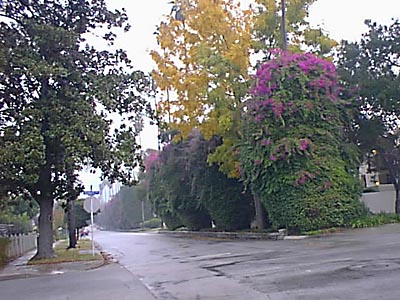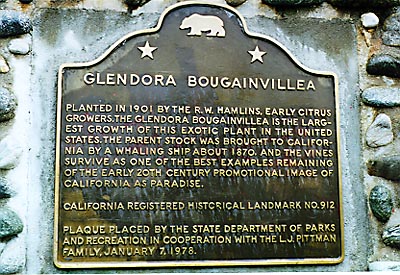 The Glendora Bougainvillea is the largest growth of Bougainvillea in the United States. Planted at the turn of the century, the vines cover the lower portion of twenty-five, ninety-foot palm trees, stretching for 600 feet along Bennett Avenue and 600 feet along Minnesota Avenue. The twelve-hundred foot growth borders two sides of an orange grove owned by Dr. and Mrs. L. J. Pittman. These magnificent vines have been viewed through the years by thousands of people from all over the U. S. and other countries. The beautiful magenta to purple-colored bracts are in evidence throughout the entire year, although the heaviest bloom is in December, May, June and July. During these months there are so many florescences that the green leaves can scarcely be seen. The trunks of these giants are 18 to 24 inches in diameter.
The Glendora Bougainvillea is the largest growth of Bougainvillea in the United States. Planted at the turn of the century, the vines cover the lower portion of twenty-five, ninety-foot palm trees, stretching for 600 feet along Bennett Avenue and 600 feet along Minnesota Avenue. The twelve-hundred foot growth borders two sides of an orange grove owned by Dr. and Mrs. L. J. Pittman. These magnificent vines have been viewed through the years by thousands of people from all over the U. S. and other countries. The beautiful magenta to purple-colored bracts are in evidence throughout the entire year, although the heaviest bloom is in December, May, June and July. During these months there are so many florescences that the green leaves can scarcely be seen. The trunks of these giants are 18 to 24 inches in diameter.The soil around the vines has been kept from eroding by a 20-inch cobblestone wall which surrounds the entire grove. This wall, built in 1912, also is of historical interest. It is composed of round rocks hauled by team from the San Gabriel River bed, four miles to the west. Constructed by contractor Martin Pierce, it was bonded and capped with hand-mixed mortar. There were once many miles of cobblestone walls surrounding groves in the area, but most have been destroyed.
The Pittman orange grove, the palm trees (Washingtonia robusta) bordering it on two sides, and the Bougainvilleas, were planted by Reuben Hamlin, a former Canadian, who came to the area in the late 1800's. However, Hamlin's wife, Helen, is credited with having instigated the planting of the vines. According to information passed from owner to owner, and the recollections of residents still alive, the grove and palm trees were planted in about 1890 and the Bougainvilleas in the early 1900's. Being fertilized and irrigated as part of the orange grove, the growth was rapid. In the 1930's and 40's each of the 25 Bougainvilleas reached a height of 50 to 70 feet, forming a column of color 12 to 20 feet in diameter. In the 1950's, heavy rainfall and winds caused some of the dead palm fronds, which were the climbing frame for the vines, to start shearing off. Gradually over the years, the vines have slid down and bulged out. At the present time, some are only 20 feet in height, although others still reach 40 feet.
Being sub-tropical to tropical, the Bougainvillea cannot be grown as a year-round outdoor plant in any part of the continental United States except along the coastal region of southern California and certain parts of Florida. Even in these locations, cold nights below 32 will cause considerable dieback of the smaller branches. One of the reasons for the great success of the vines at the Pittman ranch is the flow of warm air from the Dalton Canyon on cold nights. The air flows along a temperature slot less than 1/2 mile wide. The vines, being in the center of this slot, are seldom subjected to below freezing temperatures.
It has been difficult to exactly pinpoint the year of planting of the Glendora Bougainvilleas. From the old time residents in their 70's to 90's the Pittmans have received the only pertinent data. Mrs. Keith Suydam came to Glendora in 1901 and lived within 800 feet of the planting, until 1977 when she passed away. She stated that when she and her family arrived, the vines were already growing. Mrs. Ruth Kimball Richardson, local historian, claims that her family left Glendora in 1900 and returned in 1914, at which time the vines were already quite large. Francis Detwiler attended Wilson Elementary School, located across the street from the planting, from 1914 to 1920. He remembers often retrieving baseballs from the vines. Two other prominent Glendorans, Mrs. Stanley Lawton and Mrs. C. M. La Fetra, remember being shown the magnificent display when they first came to Glendora in 1927. Melvin Shorey, manager of the Foothill Supply Company and grandson of Phillip Shorey, a prominent pioneer of Glendora, says that the Bougainvilleas were very large in 1929 when the second owner, Ivan Hanley, bought the ranch from Reuben Hamlin.
A newspaper article from 1944 states that the vines were planted by Mrs. R. W. Hamlin over 41 years before, thereby placing the date of the planting about 1903. The late Dr. Glenn Odell, who passed away recently at the age of 92 said, "I can't remember a time when the Bougainvilleas were not growing there!"
The staff of the Rancho Santa Ana Botanic Garden in Claremont, particularly Mrs. Beatrice Beck, Librarian and Mr. John Dourley, Superintendent, have contributed substantially to our knowledge of the history of the genus in California and the world. Bougainvillea is named for Louis Antoine de Bougainville, the first Frenchman to cross the Pacific. He was aide-de-camp to General Montcalm in the French and Indian Wars. When France lost her empire in Canada, he, in 1768, with the King's botanist Philibert Commerson, set sail on a voyage of discovery for France. During this voyage, Commerson found a plant in Brazil and named it after Bougainville. It was taken on their voyage to the South Pacific and later to France as a "stove plant." This is an old term applied to plants that had to be taken indoors in the winter and kept near a stove. Because they have grown so profusely in the South Pacific, people do not realize that Bougainvillea is native to South America!
It is believed that Bougainvilleas were brought to southern California by a whaling ship, about 1870. By 1895 the vines were flourishing in the citrus growing areas. In the book, Plants For Extra Tropical Regions, by Reidel, it states, "Dr. Franceschi says that both "giabra" and "spectabilis" (the two species at the Glendora site) were old-timers in Santa Barbara in 1895."
When citrus was one of the two major industries in California, tourists and laborers were being attracted by the many pictures of beautiful ranch homes in a setting of orange groves, palm trees, flowers and snow-capped mountains. Beautiful gardens flourished in the citrus communities. The period had a culture of its own, as many of the ranchers were wealthy men who had come from the east. They helped start fine colleges and generally encouraged fine arts in this part of the valley. In the 30's and 40's Glendora stores sold post cards showing the Bougainvilleas in bloom. During this time, Hollywood film crews regularly filmed the vines and the footage was shown across the nation in theaters as a promotional effort. Mrs. James Vincent, who grew up on East Bennett Avenue, remembers that it was a treat for local children to watch the movie companies shooting pictures of the Bougain- villea-covered palm trees with the orange grove and Mt. Baldy in the background. Later they were thrilled to see these pictures at the theater.
 On January 7, 1978, the Glendora Bougainvillea was approved for listing in the National Register of the Department of the Interior, giving it Federal protection and making it eligible for a grant-in-aid under the Historic Preservation Act of 1966.
On January 7, 1978, the Glendora Bougainvillea was approved for listing in the National Register of the Department of the Interior, giving it Federal protection and making it eligible for a grant-in-aid under the Historic Preservation Act of 1966.
The best time to visit is in May, June, July, and December. June and July are usually the months of heaviest florescence. The winter bloom in December is usually less intense. Unless there is quite a period of heavy rainfall, the Bougainvilleas have some bloom in evidence throughout the year. The display is more exciting with a moderately low sun, either in the morning or late afternoon. It is interesting to note that most of the color comes from the bracts that surround the flower. They are really a leaf-form color variation, and for this reason there are times that it seems the vines are solid flowers with practically no green leaves in sight.
Directions: Turn right (east) on Bennett from Glendora Avenue and travel 0.6 miles to the intersection of Minnesota Avenue. The monument stands about 40 feet east of this corner on the north side of Bennett Avenue.